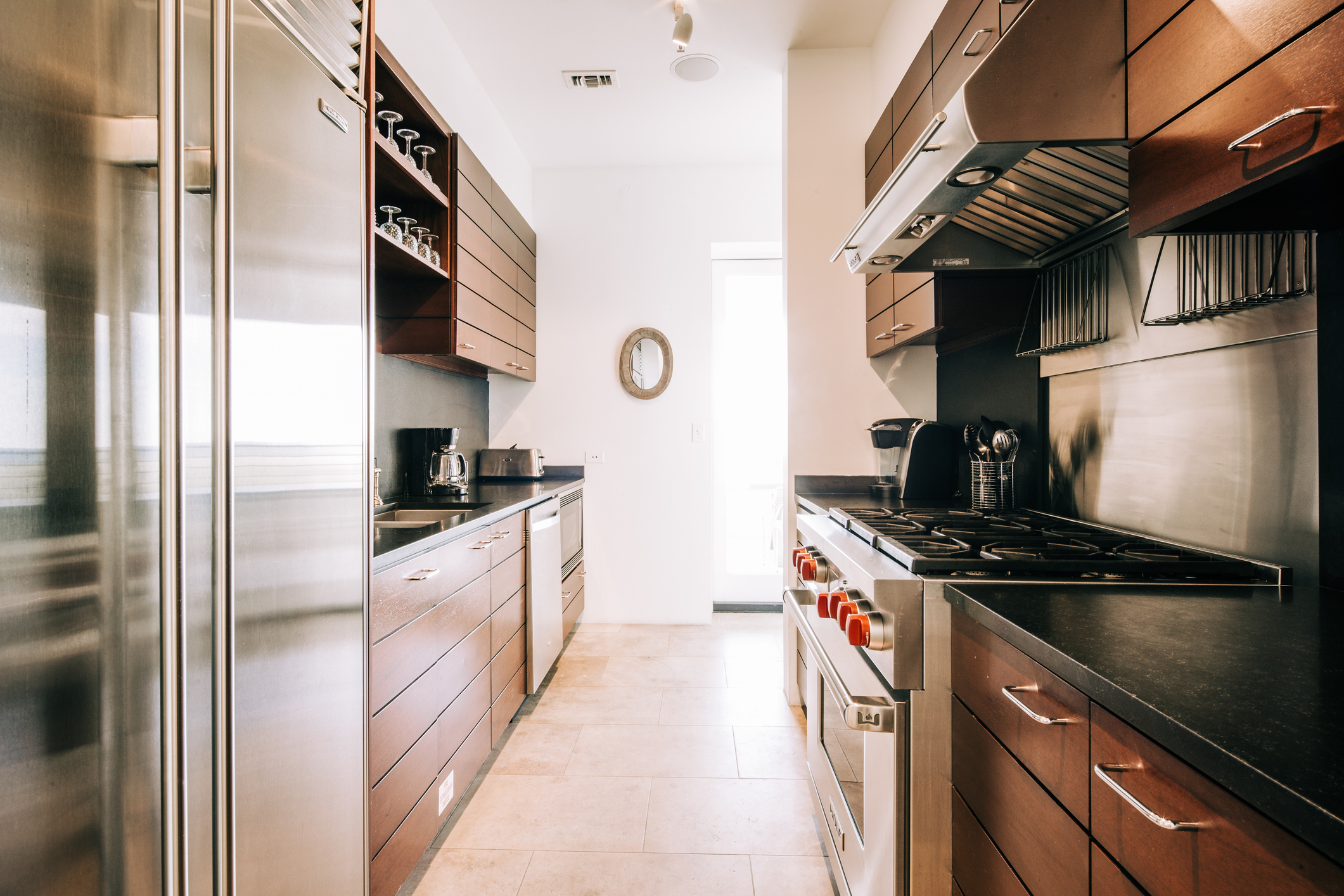
What is a Galley Kitchen? The Definition, Pros, and Cons

By Lilly Milman
Jul 31, 2024
A controversial but common feature of apartments — especially older and smaller apartments — is the galley kitchen. You may love them or hate them, but they’re here to stay. In this article, we go over why this somewhat cramped kitchen design has become a staple of apartment living and why the pros may actually outweigh the cons.
What is a galley kitchen?
The term galley typically refers to the area of a ship, train, or aircraft where food is prepared for passengers. Because floor space is limited in those settings, galleys were designed to use every inch efficiently. Eventually, this kitchen layout design made its way into our homes as well — especially in smaller homes like apartments.
A galley kitchen layout is long and narrow, characterized by the two parallel walls of cabinetry, shelving, and countertops that close it in. It looks like if a kitchen was created in a hallway, with the cook standing in the narrow aisle between the two walls. (Another term for it is a corridor kitchen). There are two kinds of galley kitchens: One where there is a “dead end,” a.k.a. another wall abutting one end of the kitchen, and another where the kitchen is actually in a hallway and there is easy traffic flow through it on either end (called a “pass-through” galley kitchen design).
The setup of this narrow kitchen is meant to follow the principles of the “kitchen triangle,” which is the idea that the primary appliances (kitchen sink, stove, and refrigerator) should be positioned diagonally across from each other in the shape of a triangle. In a galley layout, the cook would ideally stand in the middle of this imaginary work triangle, easily able to turn to whatever appliance they need in the moment.
What is the different between a galley kitchen and a kitchenette?
While a galley-style kitchen is on the smaller side, it’s still a full-sized kitchen with full-sized appliances. Meanwhile, a kitchenette is like a partial kitchen. It’s much smaller in size, typically set up against one wall of a studio apartment, and may only come with mini appliances (like a mini fridge or a one- to two-burner stove). A kitchenette will also have even less kitchen cabinets and counter space, and is more suited to renters who rarely cook — while galley kitchens are robust enough to support dedicated home cooks.
What are the pros of galley kitchens?
There’s a lot to love about a galley kitchen. Below are just a few positives:
- Space efficiency. Property owners love galley kitchens because they are more affordable to build during a kitchen remodel and they use less square footage in smaller spaces. Because they make such efficient use of the small spaces they take up, galley kitchens are one of the go-to designs for apartments with smaller floor plans. And if you are someone who values kitchen space less than the rest of your living space, a space-saving galley kitchen may feel like the perfect fit for you.
- Easy access to appliances. As we said earlier, the kitchen triangle is a very effective way of laying out the major appliances (the sink, the refrigerator, and the stove). In larger kitchens, you may find yourself needing to walk around to reach each of these appliances, which is less efficient and can actually hamper cooking efforts.
- More privacy. Do you ever stress about company coming over and seeing your mess of a kitchen? With a galley kitchen, it’s easier to hide those dirty dishes in the sink. Because it’s tucked away in the corner of your apartment, and typically boxed in with two walls, it encourages less foot traffic and will be more out of sight than an open concept kitchen that opens into the living room.
What are the cons of galley kitchens?
However, open concept gourmet kitchens are in style right now — and many people think for good reason. Here’s why you may not want a galley kitchen:
- Feels cramped. If you’re the type of person who feels stressed in closed in spaces or has tons of dish- and cook-ware, a galley kitchen may not be the right fit. It has a more cramped design than an open concept kitchen: When you’re cooking in a galley kitchen, you will be closed in on all sides and feel like you have less breathing room. It’s not a problem for some, but not ideal for others. Plus, it will simply be a smaller kitchen with less storage space and countertop space — and no dining area. You’ll need to create a separate eating nook.
- Only enough room for one cook. If you love cooking with your partner or roommate, a galley kitchen may make it more difficult to do so. The small kitchen triangle is really engineered for just one person, and you’d be bumping elbows with your sous chef in a galley kitchen. It’s best for solo chefs rather than multiple people.
- Less access to natural lighting. A galley kitchen will probably not be the light, airy cooking space you’re looking for. Because it’s closed in on nearly all sides by walls, this narrow space may be a little darker, and all the light will need to come from nearby windows in other rooms or overhead lighting. Again, not a huge deterrent for many renters, but can be a con for some when choosing the right type of kitchen.
The Bottom Line
A galley kitchen is one of the most functional and space efficient kitchen designs that you’ll find in any apartment. However, at the same time, it’s also one of the more cramped kitchen layouts. And if you live in a city with limited space like New York or Boston, you may be hard pressed to find a place without one. So, before you write them off, weigh the pros and the cons. They may actually be the ideal kitchen for you.
Top cities
Atlanta Apartments
1,595 apartments starting at $700/month
Austin Apartments
5,074 apartments starting at $500/month
Baltimore Apartments
1,305 apartments starting at $475/month
Boston Apartments
5,622 apartments starting at $1,050/month
Charlotte Apartments
2,837 apartments starting at $560/month
Chicago Apartments
6,256 apartments starting at $638/month
Dallas Apartments
5,511 apartments starting at $595/month
Fort Worth Apartments
2,626 apartments starting at $500/month
Houston Apartments
5,239 apartments starting at $618/month
Las Vegas Apartments
1,067 apartments starting at $650/month
Los Angeles Apartments
11,096 apartments starting at $700/month
Miami Apartments
462 apartments starting at $1,200/month
Milwaukee Apartments
1,180 apartments starting at $545/month
New York Apartments
5,073 apartments starting at $1,000/month
Oakland Apartments
788 apartments starting at $850/month
Orlando Apartments
853 apartments starting at $940/month
Philadelphia Apartments
3,084 apartments starting at $500/month
Phoenix Apartments
4,126 apartments starting at $600/month
Pittsburgh Apartments
753 apartments starting at $450/month
Portland Apartments
2,124 apartments starting at $750/month
Raleigh Apartments
1,229 apartments starting at $550/month
San Antonio Apartments
3,479 apartments starting at $574/month
San Diego Apartments
2,866 apartments starting at $650/month
San Francisco Apartments
496 apartments starting at $830/month
San Jose Apartments
431 apartments starting at $1,100/month
Seattle Apartments
3,096 apartments starting at $650/month
Tampa Apartments
807 apartments starting at $812/month
Washington DC Apartments
2,212 apartments starting at $910/month


